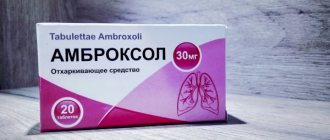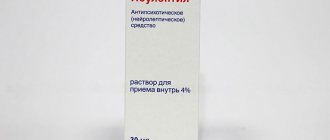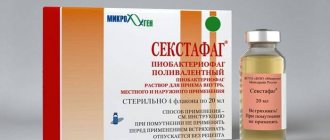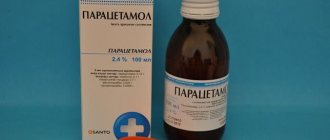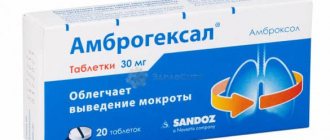Composition and release form
The drug is available in several dosage forms:
- syrup for oral administration;
- solution for nebulizers;
- pills;
- capsules;
- solution for injection (in medical institutions).
The tablets contain the main active ingredient – ambroxol, 0.3 g, as well as auxiliary components:
- lactose (Lactose monohydrate);
- corn starch (Maidis amylum);
- magnesium stearate (Magnesium stearate);
- silica.
The tablets have a score in the center. They are convex on both sides and white. Packaged in blisters, each containing 10 pcs. One cardboard package can contain several blisters: from 2 pcs. up to 5 pcs.
Capsules are a form with an increased duration of action, they contain 0.75 g of ambroxol, in addition:
- triethyl citrate;
- hypromellose;
- silicon dioxide
The capsule itself consists of gelatin, dyes and titanium dioxide. The part covering the capsule is painted brown. Inside there are white or yellowish granules. Capsules are packaged in blisters, 10 pcs. in everyone. There can be 1 or 2 blisters in 1 cardboard package.
100 ml of syrup contains a dose equal to 1 tablet - 0.3 g of ambroxol. Raspberry flavoring gives the clear liquid a pleasant aroma and taste. The bottle is made of dark glass, which protects the contents from sunlight, and is equipped with a nozzle that makes dosing easier. The syrup is supplied with a plastic measuring cup with marks on the body.
100 ml of solution for inhalation contains 0.75 g of ambroxol. The liquid is colorless and odorless. Packaged in glass bottles with a drip nozzle, which facilitates dosing when preparing solutions in a nebulizer. The packaging includes a plastic measuring cup with marks and a scale on the walls.
2 ml of solution for injection includes 0.15 g of ambroxol. Sold in ampoules, each with a volume of 2 ml, made of dark glass. 1 cardboard package contains 5 ampoules in 1 pallet.
Lazolvan or Ambrobene: which is better
Lazolvan is a drug with mucolytic and expectorant action. It is based on the same ambroxol as Ambrobene. Lazolvan is produced in the form of syrup. When choosing a medicine to improve sputum rheology, you can focus on both the price and the preferred form of release. Without the opportunity to use Lazolval for inhalation, you can choose Ambrobene. The drugs are identical and are complete analogues of each other. In pharmacies, the cost of Lazolvan is often almost twice as high as the price of Ambrobene.
Contraindications
Allergic reactions or intolerance to any component of the drug are grounds for refusing therapy and prescribing an alternative remedy.
Tablets are not prescribed to people with:
- lactase deficiency;
- hypolactasia;
- children under 6 years old.
Due to the fact that Ambrobene syrup has a sweet taste, it is not prescribed to patients with:
- fructose intolerance;
- malabsorption of glucose, galactose, sucrose, isomaltose.
How long can you drink Ambrobene?
Treatment of respiratory infections with Ambrobene can be continued for no longer than 5 days. This is justified by the fact that during this time viral infections cease their pathogenic effect, the body manages to form a reliable army of antibodies and produce a large amount of interferon, due to which the patient’s condition returns to normal. The persistence of symptoms after the 5th day of treatment indicates that the disease was caused by bacteria, so you need to consult a specialist to prescribe an antibiotic.
Carefully
Patients with congenital syndrome of slow-moving cilia of the respiratory tract epithelium should take the drug strictly under the supervision of medical personnel. This is explained by the significantly reduced activity of the receptors responsible for the cough reflex, which makes it impossible to timely remove rapidly produced mucus, leading to complications.
Tablets, capsules and syrup are not prescribed to patients with acute gastric or duodenal ulcers.
People with reduced kidney and liver function during treatment should be under the supervision of specialists who are ready to provide timely assistance if necessary.
Ambrobene - solution for inhalation for cough
Ambrobene is based on the substance ambroxol. It is a mucolytic and at the same time has an expectorant effect. It is reasonable to use Ambroxol in the form of a solution, syrup or tablets for dry cough. Any respiratory disease accompanied by inflammation of the mucous membranes of the respiratory tract will be accompanied by a cough. If it is dry, the inflammation only intensifies. For recovery, it is necessary that the mucous membranes of the affected respiratory tract produce a sufficient amount of mucus. When it leaves the body with a cough, it removes all pathogenic microorganisms, speeding up the healing process.
Side effects
Forms of the drug intended for systemic treatment, involving oral administration, may lead to the following symptoms:
- allergic skin reactions such as itching, urticaria, swelling of tissues on the face;
- fever;
- headache;
- nausea;
- weakness;
- gastrointestinal disorders.
The inhalation solution rarely causes impaired taste perception, as well as abdominal pain and anaphylactic reactions.
Indications for use
Ambrobene is effectively used to treat respiratory diseases. It easily copes with the removal of sputum and the destruction of the bacteria that cause it in acute respiratory viral infections, acute respiratory infections, bronchitis, and pneumonia. The drug is prescribed to both adults and children.
For children
Safe use of Ambrobene is possible from a very early age. So, children under 2 years old receive the solution under the supervision of a pediatrician, and older children under the supervision of their parents. The main indicator for use is cough. The drug copes well with both dry and wet forms. Ambrobene inhalations are carried out for:
- bronchitis;
- pneumonia;
- bronchial asthma.
Important! It is allowed to give the drug to children even if there is no sputum when coughing. Pathologically dangerous mucus still forms in the bronchi, the child will expectorate it a little later, with the help of ambroxol it is possible to speed up this process and bring recovery closer.
For adults
Ambrobene is indicated for diseases such as:
- acute and chronic bronchitis of infectious nature;
- chronic pathology in the structure of the bronchi;
- bronchial asthma;
- chronic obstructive bronchitis;
- pneumonia;
- tracheitis;
- cystic fibrosis;
Before using the drug, you need to consider the presence of contraindications and the existing risk of side effects.
Contraindications
The main contraindications include:
- sensitivity to its individual components;
- pregnancy;
- epileptic seizures;
- allergies.
Take the medicine with caution if:
- there are diseases and pathologies affecting the bronchi;
- sputum is formed and released at an unusual speed;
- stomach and duodenal ulcers are at the acute stage;
- kidneys are not working well;
- I have liver problems.
If a woman is breastfeeding, then prescribing the drug in question is undesirable. It easily passes into breast milk, which is not desirable and not always safe.
Taking multiple drugs at the same time
Antibacterial therapy, supplemented with Ambrobene, increases the concentration of antibacterial substances in secreted sputum.
The simultaneous use of Ambrobene with antitussives is strictly contraindicated. The liquid sputum produced should immediately leave the lungs and bronchi, thanks to the cough reflex. By suppressing a cough with means such as Sinekod, the patient dooms himself to the development of pneumonia associated with stagnation of mucus from the lungs, where a favorable environment is formed for the proliferation of pathogenic bacteria.
Is it possible to use Ambrobene for a wet cough?
Ambrobene solution is recommended to be taken only for dry, unproductive cough. If the cough is wet, there is no point in taking mucolytics and expectorants, since the body copes on its own, armed with local immunity. It is not difficult to provide yourself with a natural wet cough - just drink more than 2 liters of warm liquid per day and breathe moist air. You can bring air parameters back to normal through frequent and regular ventilation or using special air humidifiers.
Conditions for storing the drug in pharmacies and clinics
According to the letter from Roszdravnadzor, pharmacies and clinics should pay special attention to the storage of this drug due to temperature conditions, especially in the summer. The temperature of the storage location should not exceed 25°C. Violation of these conditions refers to gross violations of licensing requirements.
The pharmacy premises must maintain the required temperature and humidity. It is important to check at least once a day. To comply with the required parameters, the warehouse premises must be equipped with thermometers and hygrometers. Also, each compartment must contain a temperature and humidity level card.
According to SanPiN, expired medications must be disposed of immediately after their expiration date.
As for the transportation of medicines, they must be transported in compliance with temperature conditions, and the products must be protected from damage to the packaging, spills and contamination. Transport must be equipped with refrigeration units.
special instructions
It is not recommended to combine the product with antitussive drugs that make it difficult to remove sputum.
In rare cases, the use of Ambrobene can cause severe skin reactions (Lyell's syndrome and Stevens-Johnson syndrome). If changes in the mucous membranes or skin are observed after taking the drug, you should stop taking the drug and consult a doctor immediately.
Impact on the ability to drive vehicles and complex mechanisms
The effect of ambroxol on the ability to drive vehicles and operate moving machinery has not been sufficiently studied at the moment.
Pharmacokinetic properties
What pharmacokinetic features are inherent in Ambrobene drops? The instructions for use say that after ambroxol enters the human body, it is metabolized into cookies. In this case, metabolic products are formed, which are subsequently excreted by the kidneys.
The half-life of the drug in question is 6-12 hours. The active component of the drug for inhalation and oral administration passes into mother's milk, which should be taken into account when breastfeeding.
Overdose
In case of an overdose of Ambrobene, symptoms of intoxication practically do not appear. In some cases, increased nervous agitation and diarrhea have been reported. When the drug is taken orally in a daily dose not exceeding 25 mg/kg, ambroxol is well tolerated. When using Ambrobene in very high doses, a decrease in blood pressure, nausea, vomiting, and increased salivation are sometimes observed.
In cases of extremely severe overdose, intensive care methods, including inducing vomiting, are used as treatment. Gastric lavage is most effective only in the first 1-2 hours after taking the drug. Symptomatic therapy is also prescribed.
When is it appointed?
A doctor may prescribe Ambrobene for a 1-year-old child for the following indications:
- acute bronchitis;
- protracted form of bronchitis;
- bronchiectasis;
- obstructive pulmonary diseases;
- asthma;
- bacterial pneumonia.
Ambrobene is taken as an adjuvant therapy for difficulties in expectorating sputum during a cold.
